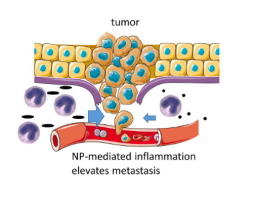Acta Biomaterialia ( IF 9.7 ) Pub Date : 2017-12-20 , DOI: 10.1016/j.actbio.2017.12.020 Bella B. Manshian , Jennifer Poelmans , Shweta Saini , Suman Pokhrel , Julio Jiménez Grez , Uwe Himmelreich , Lutz Mädler , Stefaan J. Soenen

|
Nanomaterials, such as aluminum oxide, have been regarded with high biomedical promise as potential immune adjuvants in favor of their bulk counterparts. For pathophysiological conditions where elevated immune activity already occurs, the contribution of nanoparticle-activated immune reactions remains unclear. Here, we investigated the effect of spherical and wire-shaped aluminum oxide nanoparticles on primary splenocytes and observed a clear pro-inflammatory effect of both nanoparticles, mainly for the high aspect ratio nanowires. The nanoparticles resulted in a clear activation of NLRP3 inflammasome, and also secreted transforming growth factor β. When cancer cells were exposed to these cytokines, this resulted in an increased level of epithelial-to-mesenchymal-transition, a hallmark for cancer mestastasis, which did not occur when the cancer cells were directly exposed to the nanoparticles themselves. Using a syngeneic tumor model, the level of inflammation and degree of lung metastasis were significantly increased when the animals were exposed to the nanoparticles, particularly for the nanowires. This effect could be abrogated by treating the animals with inflammatory inhibitors. Collectively, these data indicate that the interaction of nanoparticles with immune cells can have secondary effects that may aggravate pathophysiological conditions, such as cancer malignancy, and conditions must be carefully selected to finely tune the induce aspecific inflammation into cancer-specific antitumor immunity.
Statement of significance
Many different types of nanoparticles have been shown to possess immunomodulatory properties, depending on their physicochemical parameters. This can potentially be harnessed as a possible antitumor therapy. However, in the current work we show that inflammation elicited by nanomaterials can have grave effects in pathophysiological conditions, where non-specific inflammation was found to increase cancer cell mobility and tumor malignancy. These data show that immunomodulatory properties of nanomaterials must be carefully controlled to avoid any undesired side-effects.
中文翻译:

纳米粒子引起的炎症可增加肿瘤恶性程度。
纳米材料(如氧化铝)被认为具有高度的生物医学前景,是潜在的免疫佐剂,对其体积较大的同类产品有利。对于已经发生提高的免疫活性的病理生理学状况,纳米激活免疫反应的作用仍不清楚。在这里,我们研究了球形和线状氧化铝纳米粒子对原代脾细胞的影响,并观察到两种纳米粒子均具有明显的促炎作用,主要针对高长径比纳米线。纳米颗粒导致NLRP3炎性体的清晰活化,并且还分泌转化生长因子β。当癌细胞暴露于这些细胞因子时,导致上皮向间质转化的水平增加,这是癌症转移的标志,当癌细胞直接暴露于纳米粒子本身时,这不会发生。使用同基因肿瘤模型,当动物暴露于纳米粒子时,尤其是对于纳米线,炎症水平和肺转移程度显着增加。通过用炎性抑制剂治疗动物可以消除这种作用。总的来说,这些数据表明纳米粒子与免疫细胞的相互作用可能具有继发性作用,可能加重病理生理状况,例如恶性肿瘤,必须仔细选择条件,以将诱发的非特异性炎症细化为特定于癌症的抗肿瘤免疫力。当动物暴露于纳米粒子时,尤其是对于纳米线,炎症水平和肺转移程度显着增加。通过用炎性抑制剂治疗动物可以消除这种作用。总的来说,这些数据表明纳米粒子与免疫细胞的相互作用可能具有继发性作用,可能加重病理生理状况,例如恶性肿瘤,必须仔细选择条件,以将诱发的非特异性炎症细化为特定于癌症的抗肿瘤免疫力。当动物暴露于纳米粒子时,尤其是对于纳米线,炎症水平和肺转移程度显着增加。通过用炎性抑制剂治疗动物可以消除这种作用。总的来说,这些数据表明纳米粒子与免疫细胞的相互作用可能具有继发性作用,可能加重病理生理状况,例如恶性肿瘤,必须仔细选择条件,以将诱发的非特异性炎症细化为特定于癌症的抗肿瘤免疫力。
重要声明
已经显示出许多不同类型的纳米颗粒具有免疫调节特性,这取决于它们的物理化学参数。可以将其潜在地用作可能的抗肿瘤疗法。但是,在当前的工作中,我们表明,纳米材料引起的炎症在病理生理状况中可能会产生严重影响,在病理生理状况中发现非特异性炎症会增加癌细胞的移动性和肿瘤恶性程度。这些数据表明,必须小心控制纳米材料的免疫调节特性,以避免任何不希望的副作用。


























 京公网安备 11010802027423号
京公网安备 11010802027423号